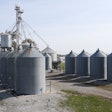Dry conditions at harvest have resulted in some of the highest Hagbergs recorded in the past few years in the Agriculture and Horticulture Development Board/Home Grown Cereals Authority (AHDB/HGCA) Cereal Quality Survey estimates released September 9.
Overall, Great Britain wheat quality analyzed so far by AHDB/HGCA, from 17,720 samples collected up to August 30, shows large improvements on the 2012 crop, with average Hagbergs of 334 seconds and an average specific weight of 77.8 kilograms per hectoliter. However, these results are affected by the fact a large proportion of samples to date are from the east of England, where the greatest harvest progress has been made, and are predominantly from nabim group one and two varieties.
Great Britain barley specific weights at 67.9 kilograms per hectoliter from 12,884 samples are encouraging, currently the highest since 1999, but screenings indicate grain size is smaller than average size pre-2012.
Amandeep Kaur Purewal, senior analyst for AHDB/HGCA, said, “As harvest progresses and more nabim group three and four samples are included in the wheat analysis, there will be changes to the wheat data.
“Compared to 2012, overall samples for both wheat and barley have improved, but the real question must be how quality parameters will finally compare to more typical years rather than focusing on year-on-year comparisons.”
The AHDB/HGCA Cereal Quality Survey results will be updated in October with final results published in November.
Wheat
As of August 27, 2013, only 40 percent of Great Britain wheat area had been harvested, so that the data provided is subject to change once more samples are collected and harvest draws to a close.
- Specific weight, at 77.8 kilograms per hectoliter is higher than last year’s final figure and more in line with the values recorded pre-2012. The approximate range for 2013 was 71.3-83.9 kilograms per hectoliter.
- The provisional 2013 estimate of 334 seconds for the Hagberg Falling Number (HFN), when compared to final HFN results, is the highest since 1990. This is due to dry weather conditions once the crop was ready to harvest. (Range: 220-443 seconds).
- Protein content is lower than last year at 12.4 percent, but above the three year average of 12.1 percent. The approximate range is between 10 percent and 14.7 percent, which is narrower than the range obtained in last year’s provisional estimates.
- Moisture content, at 14.8percent, has returned to levels prior to 2012, with a range of 12-18 percent.
Barley
Spring barley represents just over half of all the samples analyzed. This proportion is expected to increase when results are updated as the harvest of winter barley was all but complete by August 27.
- Specific weight at 67.9 kilograms per hectoliter is a marked improvement on last year, but also ranks as one of the highest weights in the past eight years. (Range: 62.0-73.5 kilograms per hectoliter)
- Nitrogen content at 1.66 percent is higher than the final result obtained last year, and above the three year average. (Range: 1.2-2.1 percent)
- Screenings: Although these results have improved compared to last year, they have not returned to the average prior to 2012. The percentage of grain passing through a 2.25 millimeter sieve was 2 percent, while the proportion retained by a 2.5 millimeter sieve was 92.7 percent. The range of grain retained was 77-99 percent, whilst the range for grain passing through the sieve was 0-8 percent.
- Moisture content is one of the lowest since 2005 at 14.6 percent. (Range: 11.9-17.7 percent)
















